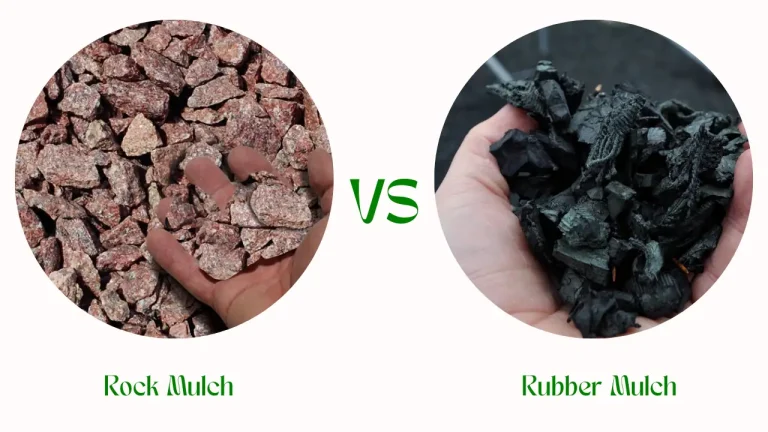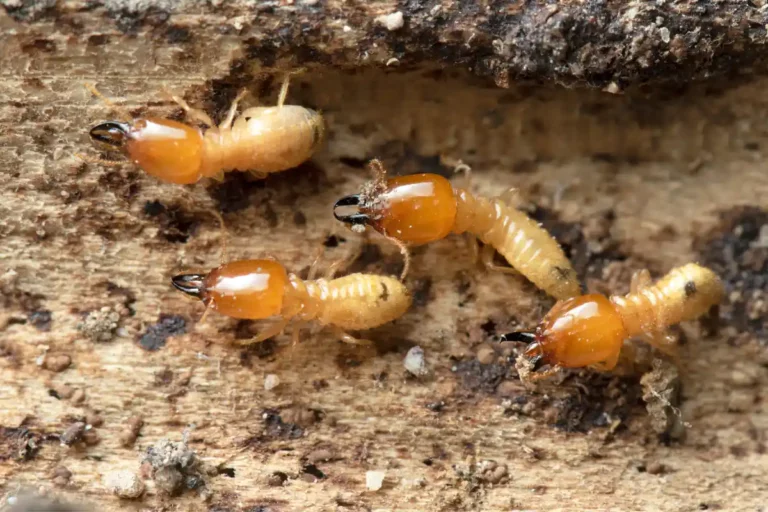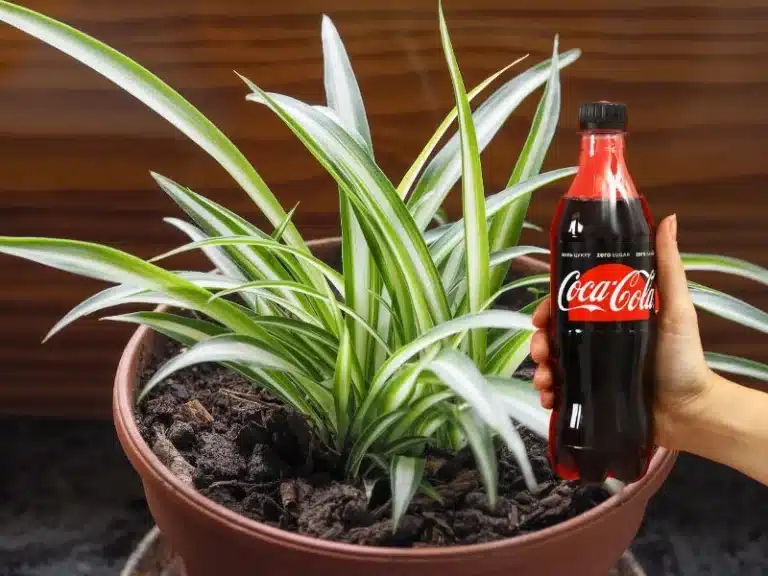Hoop House vs Greenhouse: Differences, Cost + Uses
A hoop house and a greenhouse share many similarities the main one being that they’re two of the most used season extension methods for crop farmers. With either of them, you can grow your plants no matter the season as they provide conducive conditions no matter the conditions outside.
The main difference between a greenhouse and a hoop house (high tunnel) is that a hoop house is taller with high posts than a greenhouse. In greenhouses, heat control is done artificially while in hoop houses, temperature control is natural through doors and window openings.
They, however, have a good number of differences in terms of their costs, the seasons they’re needed, the sizes and other aspects. Choosing between the two structures depends on the season, the crop in question, and the available capital.
Hoop House vs Greenhouse: Differences
The main differences between a hoop house and a greenhouse are as follows:
1. Heating and cooling methods
When it comes to controlling the heat and air inside the two structures, the greenhouse has exhaust fans, heaters, and grow lights to maintain certain conditions of the structure. This ensures that the conditions within the structure are kept within certain limits.
On the other hand, climate conditions in the hoop house are manually controlled by opening and closing the end walls. In the mornings when the temperatures are expected to be high, the end walls are lifted up.
This allows the free circulation of air and moisture within the hoop house. In the evenings and when the conditions are expected to be chilly, the walls are brought down to increase the temperature inside the structure.
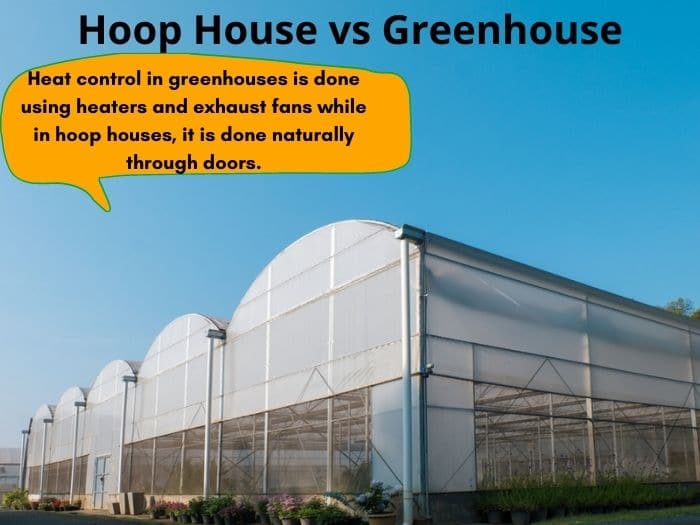
One thing to take note of is that hoop houses tend to be a hybrid between a controlled environment and greenhouse conditions. While they mainly work manually, there are cases where electricity is needed in a hoop house to warm it (such as in the winter months).
2. Costs
In terms of the setup and operational costs, you’ll spend much less on a hoop house or high tunnel than a greenhouse. First, hoop houses are usually smaller than greenhouses. This means you’ll need less materials to build them as compared to a greenhouse. You’ll also need less labor to for the same.
The other aspect making hoop houses less costly is the operational costs. Unlike a greenhouse which needs electricity to keep certain conditions, a hoop house needs little to no electric power to run.
[amazon box=”B084X7XKFH”]
Besides that, you can get grants for hoop houses from the Natural Resources Conservation Service (NRCS) through its Environmental Quality Incentives Program. This program applies to hoop houses and high tunnels as well.
3. Space needed
For greenhouses, they can be as large as whole cities depending on the amount of space required and that which is available. Essentially, if you want to carry out large scale farming for tender plants such as short and tall tomatoes in a controlled environment, then you should go for a greenhouse and not a hoop house.
Hoop houses tend to be smaller and less connected to other structures or other hoop houses. Usually, if you need a larger hoop house, you simply take away one wall then create another section of it. Beyond a certain size, a hoop house morphs into a greenhouse.
4. The targeted seasons
If your plan is to have a seasonal crop in the fall or spring and not in the major seasons of summer and winter, a hoop house is the more reasonable option given that it’ll allow you control the conditions in the structure without spending much on it.
On the other hand, if your crop grows through the hot summer and chilly winter, you should go for a greenhouse as it enables you control the conditions inside better due to having electricity running appliances to keep the excessive cold and heat out.
These differences determine what kind of structure between the two you’ll choose as per your needs and available resources. Basically, if you need more crops and in a more corralled environment, the greenhouse is your best bet. If the prevailing conditions require only minimal tweaking, a hoop house is enough.
Uses of a hoophouse
Some of the uses of a hoop house include the following:
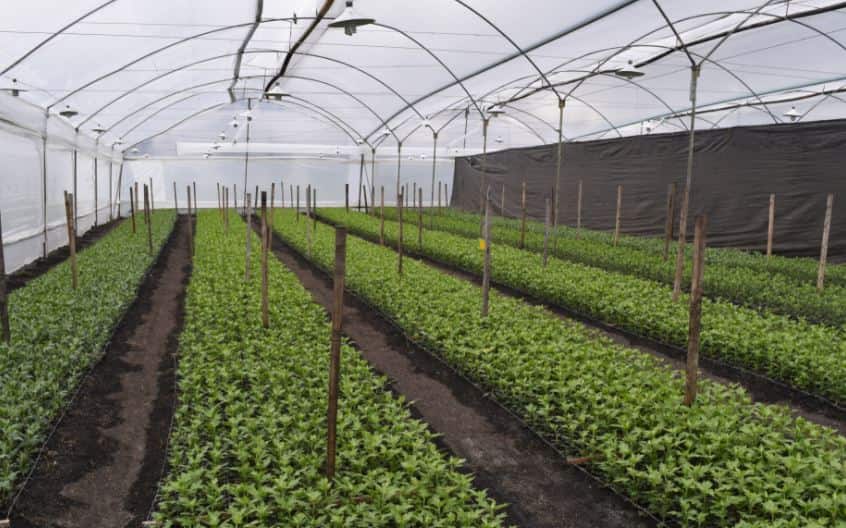
1. Extending the growth season
The primary purpose of hoop houses, greenhouses and other similar structures is to allow for the growth of crops all year round. It does this by shielding the plants from the cold, heat and extreme winds.
2. Providing better plant management
In a hoop house, you have more control on the growth of the plants in terms of their nutrition, growth cycles and other aspects. In comparison to the growth of the same plants in the field, you’ll need less effort and costs to determine the growth of the plant in a hoop house.
3. Enabling better soil management
With the controlled conditions inside a hoop house, you can also control the soil in terms of the moisture content, the pH, temperature and other aspects. You’re also in control of the amount of tilling you can do to the soil, the amount and type of fertilizer to add and when to apply it.
4. Providing better water management
The water management in a hoop house is twofold: in the soil and the humidity inside the hoop house. For the water in the soil, pipes or sprinklers are used to deliver water to the roots of the plants in the required amounts. The level of humidity can also be controlled with humidifiers and other methods.
5. Saves on costs
By controlling how much water, nutrients, pesticides and other inputs are used in a hoop house, you save on the costs of production while getting the best yields from the crops.
In the wild, a lot of inputs go to waste due to winds, heat and the cold. Given that the plants are also protected means that they’re less likely to get infected with diseases and pests.
6. Helps meet demand for fresh produce
Hoop houses make it possible to availfresh farm produce all year round. Given that the demand for such foods is always high, hoop houses are a cost-effective way of meeting it no matter the season.
For this reason, a farmer’s profits will be higher than if they depended purely on the seasonal weather to grow the crops.
Cost of a hoophouse
Hoop houses, high tunnels and greenhouses are measured in square feet. For a hoop house, the coat is about $1 per square foot. This is purely the cost of the materials with the labor costs depending on how big the hoop house you want is. It doesn’t, however, require too much labor to erect and run one.
Pros and cons
Some of the pros and cons of a hoop house are as follows:
Pros
- Eliminates the dependence on seasons when growing crops.
- Good plant management.
- Good water management.
- Cost effective.
- Good soil management.
- Avails fresh farm produce to meet demand.
- Easy to assemble.
- Offer more space to work and move inside.
- Quite robust structurally hence can withstand turbulent weather quite well.
Cons
- Compared to other structures of a similar kind, hoop houses are a bit difficult to construct.
- Can be quite costly in areas with extreme weather as you’ll need extra equipment such as those found in greenhouses.
As seen here, the benefits of a hoop house far outweigh the issues associated with them.
Uses of a greenhouse
Some of the uses for a greenhouse include the following:
1. All-weather gardening
With a greenhouse, you can easily plant any type of crops you want no matter the season. Even better than hoop houses, greenhouses have more optimized conditions indoors making it easy to attain the specific conditions your plants want. They’re much better than hoop houses in extreme weather.
2. Provide better plant management
With the conditions created by a greenhouse, you have better control on the growth of the plants since you provide the best growth conditions. You can determine how much nutrition to provide as per the behavior of the plants and other aspects. You can also keep pests and diseases away from the plants much easier.
3. Better water management
Just like in the hoop house, a greenhouse gives you better control on the amount of water to use on the plants. They’re even better than hoop houses which depend more on the prevailing conditions outside the structure. With a greenhouse, you can employ equipment such as humidifiers which provide more accurate growth conditions for the plants.
4. Enable better soil management
From controlling the amount of water, fertilizer and other aspects of the soil, you also get better control of the soil in terms of the amount of tolling you need to do and other aspects in a greenhouse. In most cases, individual plants will have the needed soil management practices and methods required unlike in the open field where it’s tough doing that.
5. Provide fresh food all year round
The closely-controlled conditions in a greenhouse make it possible to produce virtually anything no matter the conditions outdoors. You can tune the conditions inside to reflect a hot summer when it’s deep and in the winter. As such, any food that’s in demand can be produced without difficulty. The result is that your income as a greenhouse farmer will be consistent.
With these uses, you spend less on farming since you won’t be having wastage of resources such as pesticides, fertilizer, water and others.
Cost
On average, a greenhouse costs about $25 per square foot. That means that you’ll incur more the bigger of a greenhouse you construct. The cost might also go up or down with the quality of materials being used.
Pros and cons of a greenhouse
The pros and cons of using a greenhouse are as follows:
Pros
- Allows for increased production given the controlled environment for the crops.
- Maximizes on the profits in a limited amount of space for farming.
- Enables farming no matter the season.
- Minimizes on the costs of production.
- Better control of weeds, pests and diseases.
- Provides a steady and reliable source of income.
Cons
- Need a heavy initial investment.
- High production costs.
- Conditions created in the greenhouse are conducive to most pests s d diseases hence more effort needed to fight them.
- Not easy to set up since they need specific dimensions to work properly.
- Setup and running require skilled labor and lots of dedication which may kit be readily available.
- Needs a steady market to have good yields and income.
With proper planning, you can easily make a lot of money with greenhouses. The setup and market conditions are of paramount importance.
Which one to choose
The choice between the two types of controlled environment structures is highly subjective. If you’re low on costs, need to grow less crops and don’t plan on having the crops all year round, a hoop house is the best option for you. It’ll cost less to set up, run and expand when the need arises.
On the other hand, if you plan on farming on a relatively larger piece of land, want the crops all year round and have the costs to invest, a greenhouse makes more sense to you. You’ll spend more but still earn more in the end with this option.


